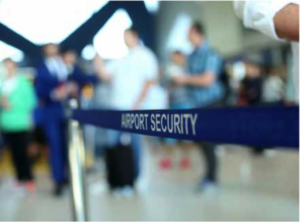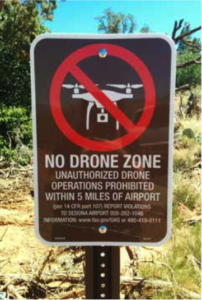All airplane flights begin on the ground. An airport is the starting point, but airspace issues continue to expand from the terrestrial to the aerial. Altitude is no barrier when countries claim sovereignty from the Earth to beyond the stratosphere.

© COLICARANICA – DREAMSTIME.COM
Airport control relies on readily available methods, from the mundane (like fences and doors with alarms) to the invisible (surveillance cameras and motion detectors). Security methods continue to evolve, but most experts agree the best deterrence takes place before a would-be miscreant ever gets to the terminal. Screening passengers (not to mention crew and airport staff ) for contraband is routine if overrated. We all know of mistakes by Transportation Security Administration personnel who’ve let potential hazards pass by unnoticed — and nothing bad has happened.
“Security is both a feeling and a reality, and the two are different things. People can feel secure when they’re actually not, and they can be secure even when they believe otherwise,” noted Bruce Schneier, a self-described public- interest technologist who works at the “intersection of security, technology, and people.”
He pointed out, “Airport security is the last line of defense, and it’s not a very good one. What works is investigation and intelligence: security that works regardless of the terrorist tactic or target.”
Kevin Garrison, a retired senior airline captain who writes frequently about aviation, predicted, “Security will have to become invisible and so easily done that nobody thinks about it anymore.”
Keep in mind airplane terrorism has always been incredibly rare. According to Schneier, “The risk is no greater today than it was in previous decades.” He noted the drive to the airport is still more dangerous than the flight. According to the Highway Loss Data Institute, there were 33,654 fatal motor vehicle crashes in the United States in 2018, in which 36,560 deaths occurred. This resulted in 11.2 deaths per 100,000 people. Aviation deaths? Fewer than 400 in 2018, said the National Transportation Safety Board. The overwhelming majority of aviation fatalities involve small, private airplanes and not large commercial airliners.
Airports are slowly renovating to provide more amenities to their highest revenue passengers, from dedicated check-in desks to chauffeured rides across the tarmac at flight departure. Lounge construction continues. At Tokyo’s Haneda Airport, Delta Air Lines started construction on a new Sky Club set to open in early July. (The carrier transferred its Tokyo-bound flights from Narita Airport to Haneda earlier this spring.)
Airports represent the public face of air travel, and the International Air Transport Association expects some $1.2–1.5 trillion to be spent on global airport infrastructure development in the coming decade. Meanwhile, airlines also work to make timely operational projections available to passengers. Delta, for instance, launched SkyWatch Daily Outlook to provide its customers with timely information on flight delays and cancellations.
What about after takeoff ? The airspace just above airports has been under assault from birds (think about geese sucked into airplane engines), not to mention the potential dangers of drones and laser pointers.
Airports have tried a variety of methods to scare birds away, from fireworks to loud noises, but one of the most successful seems to be the use of falconers and their birds of prey. Falcon Environmental Services’ wildlife control officers do the job at Toronto Pearson International Airport and Montréal’s Pierre Elliott-Trudeau International. Trained dogs also have been successful in chasing birds from runway areas.

© EMILY743 – DREAMSTIME.COM
As for drones, federal rules forbid operating a drone within five miles of most airports or above 400 feet without a waiver from the Federal Aviation Administration. You must get permission in advance from air traffic control to fly in the controlled airspace of an airport — and that’s only possible if you already have a Remote Pilot Certificate and are following Part 107 of FAA regulations. Drone experts think the airport sightings reported thus far are in the same category as UFO sightings. As Vic Moss, a founder of Drone U, a drone-operator school based in Albuquerque, New Mexico, said, “It’s possible, but it’s just incredibly unlikely that it was an actual drone.”
Lasers? Most laser pointers aren’t powerful enough to reach an aircraft in flight. During takeoff and landing, however, planes are closer to the ground, and it’s possible (although unlikely) to angle a laser such that it interferes with a pilot’s vision — though it is difficult to keep a handheld laser focused on a moving target.
In the air, commercial jets fly routes around the world, including high above some hot spots such as the Crimea, Iraq and Libya. Despite a handful of high-profile incidents (such as the targeting of a Ukrainian commercial airliner departing from Tehran recently, and the downing of a Korean Airlines passenger jet when it inadvertently strayed into restricted Russian airspace in 1983), the dangers are seen as almost negligible because each airliner’s route is calibrated to avoid recently determined no-fly zones.
What’s ahead? In the short term, airlines are reassessing their reliance on the hub-and-spoke routing that’s become routine in recent years. It’s increasingly seen as inefficient both in flying time for passengers and fuel use by aircraft, noted Garrison, the retired pilot.
Other guesses? Hyper loop or just super-fast trains connecting cities with larger airports. Right now, for example, if it takes five hours or less to drive between destinations, driving is faster than flying, once you calculate transit time to and from airports, check-in times and time in the air. Anyone who’s ridden the rails in China, Japan or much of Europe knows high-speed train travel can prove more efficient than flying and can free up airspace gridlock issues resulting from rapid aviation growth, another issue facing the industry.
The IATA recently inked a global intermodal memorandum of understanding with the International Union of Railways specifically to work on coordination. The airport at Frankfurt-am-Main, for example, includes a train station served by long-distance, high-speed trains.
“The United States still has the safest, most efficient airspace and airports in the world,” noted Shelly deZevallos, president, West Houston Airport. However, she said, “The last major airport built in the United States was in 1995 — Denver International — more than 15 years ago. This in no way keeps up with our aviation growth needs.”
Urban Air Mobility is one up-and-coming development requiring redesigned airports, she reported. NASA defines UAM as “a safe and efficient air transportation system where everything from small package delivery drones to passenger- carrying air taxis is operating above populated areas.” Changes in airport layout would be critical for its success: Instead of terminals between runways, passenger drop-off and loading should be to the side, DeZevallos noted, to avoid collisions.
What’s in the far future? Certainly, space tourism. It’s been promised for decades, but recent advances bring the concept closer to reality. Space flight will be available to civilians as well as astronauts and, perhaps, will serve as flights between far-flung earthly destinations. It’s such a hot topic, Embry-Riddle Aeronautical University already offers a course in Space Tourism.“WithVirgin Galactic now close to completing construction on its second commercial spacecraft, the wait is nearly over,” predicted Dr. Robert Goehich, who teaches the course via Embry-Riddle’s worldwide campus.
Read This Next

Introducing
FX Excursions
FX Excursions offers the chance for once-in-a-lifetime experiences in destinations around the world.
#globility
Insta FeedDaily
May 8, 20255 Destinations for a Fourth of July Getaway
Get a jumpstart on Fourth of July travel plans and book a trip to one of these patriotic destinations.
Sponsored Content
Seoul: Your Next MICE Destination
Seoul has rapidly become a leading global MICE hub, known for its rich culture, advanced technology and strong economy. As the capital of South Korea, it offers a strategic location in East Asia and a booming cultural influence through K-pop, K-movies, Korean cuisine and K-dramas. With its vibrant atmosphere and business-friendly environment, Seoul is increasingly the top choice for MICE organizers and corporate travelers seeking connection and collaboration.
Daily
May 8, 2025New Taipei City Art Museum Opens
After years of preparation, New Taipei City’s first public art museum, New Taipei City Art Museum, opened at the end of April. Positioned as a public art museum, NTCAM aims to become more than just a cultural landmark by seeking to actively engage with citizens, international visitors, artists and the broader community in Taiwan through dialogue and collaborative projects.
Daily
May 8, 2025Fort Lauderdale Hosts Third Annual Sports Fishing Competition: The Catch
The third edition of Sports Fishing Competition’s The Catch, powered by Verizon, returned to Fort Lauderdale’s scenic marina this past April, bringing current and former professional football players together to compete in an offshore fishing pro-am against 16 professional SFC angling clubs and competitors.
Sponsored Content
Explore Europe with the Best River Cruise Line this November
Experience Europe from a fresh perspective with AmaWaterways, just awarded Best River Cruise Line by Global Traveler for the third consecutive year. Step aboard, unpack once and embark on a cruise through iconic capital cities and awe-inspiring landscapes. AmaWaterways' ships, which accommodate an average of just 156 guests, offer a spacious yet intimate setting. Throughout your journey, you'll enjoy exquisite farm-to-table dining; unparalleled service; and a variety of included excursions, from city tours for gentle walkers to thrilling bike rides along the rivers.
Daily
May 7, 2025Welcome Spring with The Ritz-Carlton New York, Central Park’s Picnic in the Park
There’s a lovely alchemy that takes place when you mix sunshine and a leafy park. Add a picnic basket full of goodies and you’re on your way to a memorable outdoor escape. At The Ritz-Carlton New York, Central Park, guests can embrace springtime in the city with a gourmet picnic-to-go lunch in Central Park, featuring fresh fare thoughtfully curated by Executive Chef Andrew Burriesci.
ZURiTO Review
eFlyer Reviews
May 7, 2025eFlyer Deals
May 7, 2025Book This New Girls Getaway Offer from Sheraton Kauai Coconut Beach Resort
This summer, take a girls’ trip to Hawai’i, save big and experience unforgettable moments. Sheraton Kauai Coconut Beach Resort debuted a new Girls Just Want to Have Fun promotion.
Sponsored Content
Find Your Perfect Escape with Paradisus by Meliá — More Than Just All-Inclusive
Luxury travel today is about more than just beautiful accommodations — it’s about experiencing the destination. Paradisus by Meliá takes traditional all-inclusive resorts to the next level by offering indulgence with immersion, experiences and authenticity. Each resort is shaped by its location, local flavors and curated Destination Inclusive® experiences that bring you closer to the heart of the destination.
eFlyer Deals
May 7, 2025Mexico Grand Hotels Extends Cinco de Mayo with Limited-Time Promotion
Cinco de Mayo may be over, but that doesn’t mean the celebrations have ended. Mexico Grand Hotels extends the festivities of the Mexican holiday with its 5 de Mayo sale.
ShareThis